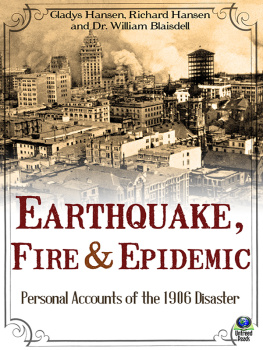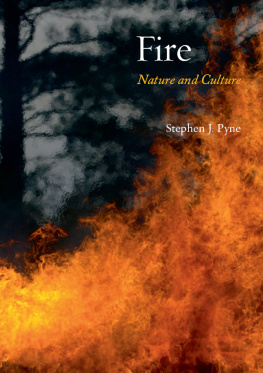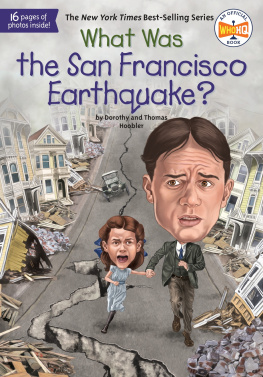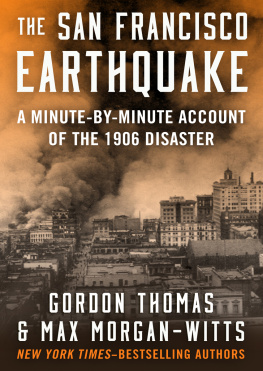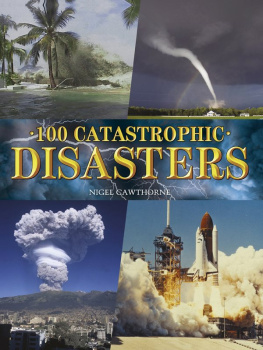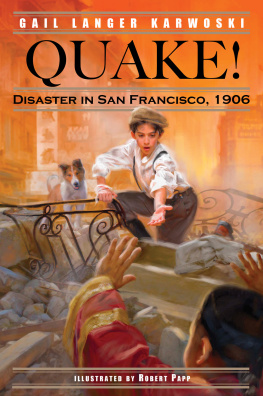Earthquake, Fire & Epidemic:
Personal Accounts of the 1906 Disaster
By Gladys Hansen, Richard Hansen, Dr. William Blaisdell
Copyright 2013 by Gladys Hansen, Richard Hansen, Dr. William Blaisdell
Cover Copyright 2013 by Ginny Glass and Untreed Reads Publishing
The author is hereby established as the sole holder of the copyright. Either the publisher
(Untreed Reads) or author may enforce copyrights to the fullest extent.
All photos courtesy of Museum of the City of San Francisco
This ebook is licensed for your personal enjoyment only. This ebook may not be resold, reproduced or transmitted by any means in any form or given away to other people without specific permission from the author and/or publisher. If you would like to share this book with another person, please purchase an additional copy for each person you share it with. If youre reading this book and did not purchase it, or it was not purchased for your use only, then please return to your ebook retailer and purchase your own copy. Thank you for respecting the hard work of this author.
While the authors have made every effort to provide accurate telephone numbers and Internet addresses at the time of publication, neither the publisher nor the authors assume any responsibility for errors, or for changes that occur after publication. Further, the Publisher does not have any control over and does not assume any responsibility for author or third-party websites or their content.
http://www.untreedreads.com
Earthquake, Fire & Epidemic
Personal Accounts of the 1906 Disaster
Gladys Hansen, Richard Hansen, Dr. William Blaisdell
Contents
NOTES
Following are a few notes of clarification about the personal accounts contained in this book:
Most of the 1906 letters were written by hand in haste to alert families elsewhere as to what happened to people during the earthquake. There are spelling and grammatical inaccuracies and inconsistencies in the letters; however, we felt it was important to provide the letters just as they were written.
It might also appear that there are errors and inconsistencies in the spelling of some street and location names. In fact, the spelling of street names, in particular, changed over time. We have retained the spellings the street names when they were being referenced.
Wherever possible, there are specific attributions included for all personal accounts, and news reports. In 1906, however, newspaper reports were often printed with no byline or reporter designated, which is why in some instances there is a publication listed, but no reporters name.
Additionally, some stories and reports included were received from various sources. Unless specified, the source of all material is from the collection of the San Francisco Earthquake Project.
The San Francisco Earthquake Project, the Virtual Museum (VM), the website www.sfmuseum.org, and the San Francisco Museum of the City of San Francisco are all referenced in the text. Though these are all different entities, they all were created and exist because of the time, dedication, research, commitment and caring of Gladys Hansen, with the great assistance of her son, Richard Hansen, who now manages the massive projects, which continue to evolve and grow on a daily basis.
Because of the electronic format for this book, we have included only a few photos, to give the reader a sense of the stark reality of San Francisco at the time. There are many, many more photos on the San Francisco Museum site.
For 50+ years Gladys Hansen has worked to create a List of the Deadan accurate reporting of those who perished in the 1906 San Francisco Earthquake. This is the most comprehensive list in existence, and a valuable resource for interested readers, academics and those hoping to trace a potential personal connection to someone who was lost in the disaster.
The List is continuously being updated as more information is unearthed, and the List will be made available in the summer of 2013 for special viewing at www.sfmuseum.org. In addition, on the site, coming soon, and available in other media are maps, photos, and a vast amount of information! We hope you will visit the site for the most recent List, and to discover even more, and expanding, information concerning the events and people of The 1906 San Francisco Earthquake, Fire and Epidemic.
INTRODUCTION
This book is devoted to personal stories of real people who experienced the great disaster of the 1906 San Francisco Earthquake and Fire. We hope to accomplish what the original History Committee promised, but was unable to do, which is to provide the personal narratives that tell the real story of the Great Earthquake and Fire of 1906. These personal accounts of death, crime, violence and disease conflict with statements by politicians who, at the time, attempted to protect the image of San Francisco by minimizing this great tragedy.
The historical interest of one of us, Gladys Hansen (G.H.), was a result of requests submitted to her at the San Francisco Public Library for specific information regarding who died in the Disaster. Finding that no such information existed, she began collecting information about deaths from the Earthquake and Fire, as well as considerable collateral information and personal narratives from survivors. Her research raised questions about what happened with the work of the original History Committee and the data they collected.
An Earthquake History Committee was formed in 1906, under the leadership of Professor Henry Morse Stephens, to compile the history of this Great Disaster, and to document the damage to human life and resources. An important publication was to be forthcoming, but this never happened. Following Stephens death the body of the supposed work simply disappeared.
The San Francisco Examiner, in a special Earthquake Edition in 1908, described the development of this original committee and provided an interval report.
April 18, 1906, Wednesday. The morning of the earthquake, faced with a disaster of unpredictable magnitude, Mayor Eugene E. Schmitz hurriedly appointed a committee, known as the Citizens Committee of Fifty, and called those who could be reached for a meeting at the Hall of Justice, at Kearny and Washington Streets that afternoon at 3:00 p.m. Emergency relief measures were all the committee could address that afternoon, and they adjourned to meet again the following morning at the Fairmont Hotel. As they continued to meet and to deal with many diverse problems, numerous subcommittees were formed.
One of the subcommittees initiated was the Earthquake History Committee which was led by Henry Morse Stephens, eminent historian and University of California professor. The Committee received financing from the Red Cross and the Relief Corporation. For two years the Committee worked diligently gathering material. In May 1906 Stephens discussed the charge to his committee:
Since memory is treacherous the first resolution of the committee was to gather together as soon as possible, a record of the personal experiences of as many people as possible during the past ten days with a full realization of the fact that although the memories of individuals might lapse here and there into inaccuracy and might swell here and there into exaggerations, yet out of the collation of hundreds of personal experiences the truth might be reached, as it can be reached through the cross-examination of many witnesses in a trial at law.
The next step was to secure the personal statements of individuals and groups of individuals who had taken an active part in the proceedings of the critical period. Then came the securing of the documents, which recorded the various steps taken for the government and relief of the citizens of San Francisco. But this was not enough. Behind statements of fact and recollections recorded while memory was still comparatively fresh, was the vast mass of impressions of proceedings and doings day by day, which under our modern civilization finds expression in the daily press.
Next page
